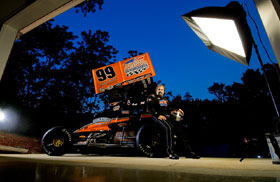 Hi and welcome to this edition of Workshop at the Ranch. The strength of a sports photographer is in their ability to freeze the action and capture an athlete making the key moment during competition. This tends to come easy for those who cover sporting events on a regular basis. But on many occasions the sports photographer is called upon to do an athletes portrait and although it might not be our strongest photographic talent I want to encourage those who call the courts, fields and stadiums of America their office to be ready when the phone rings and you are asked to do a portrait. More often than not making a good solid portrait will lead to bigger assignments inside the organization and team. When a photographer turns down the job of taking a portrait the PR person will go to someone else ………. and usually never return to you. I’ll admit it, portraits are not my strong point but I like to do them and improve each time I go out the door to do one. Practice and be ready to do this basic job of photography.
Hi and welcome to this edition of Workshop at the Ranch. The strength of a sports photographer is in their ability to freeze the action and capture an athlete making the key moment during competition. This tends to come easy for those who cover sporting events on a regular basis. But on many occasions the sports photographer is called upon to do an athletes portrait and although it might not be our strongest photographic talent I want to encourage those who call the courts, fields and stadiums of America their office to be ready when the phone rings and you are asked to do a portrait. More often than not making a good solid portrait will lead to bigger assignments inside the organization and team. When a photographer turns down the job of taking a portrait the PR person will go to someone else ………. and usually never return to you. I’ll admit it, portraits are not my strong point but I like to do them and improve each time I go out the door to do one. Practice and be ready to do this basic job of photography.
Hi and welcome to this edition of Workshop at the Ranch. The strength of a sports photographer is in their ability to freeze the action and capture an athlete making the key moment during competition. This tends to come easy for those who cover sporting events on a regular basis. But on many occasions the sports photographer is called upon to do an athletes portrait and although it might not be our strongest photographic talent I want to encourage those who call the courts, fields and stadiums of America their office to be ready when the phone rings and you are asked to do a portrait. More often than not making a good solid portrait will lead to bigger assignments inside the organization and team. When a photographer turns down the job of taking a portrait the PR person will go to someone else ………. and usually never return to you. I’ll admit it, portraits are not my strong point but I like to do them and improve each time I go out the door to do one. Practice and be ready to do this basic job of photography.
This month’s WATR article is a portrait session with Sprint Car driver Frankie Herr. I believe the key ingredient of the success of any portrait rests on the cooperation of my subject. This can be difficult, especially if the subject is a high profile athlete with little time to spare. My evening with Frankie was a perfect scenario and will stick in my mind as one of my favorites. Frankie is a great guy, had the time and was very willing to accommodate me in an effort to make some wonderful pictures. This session was the green light to a weekend of Sprint and Super Modified car racing in the Harrisburg, Pennsylvania area (see 2007 August On The Road “Speedway Thunder from PA”). I came to Harrisburg on an invitation from my friend Bill Anderson who is a talented sports photographer and is closely embedded in the motor sports industry…….the guy knows everybody and makes terrific pictures. As a friend and colleague, he wanted me to experience first hand the great opportunity there is in capturing great images of this sport. I wanted to begin the weekend of revved up photography with a portrait of one of the top drivers and so Bill arranged some time with Frankie.
Equipment Note: Rather than being repetitive with each image information, here is the list of equipment that remained consistent throughout the shoot …. Nikon D200, Elinchrom Ranger RX Speed AS battery powered pack and sport strobe … (Note: The Ranger RX Speed AS has a 7 stop range and 1/10 positions, 7.5 being full power. In other articles including the 2007 August On The Road I have referred to the power settings in an older fashion of 1/2 or 3/4 or full power. I am becoming more accustomed to the Ranger digital display values and will try and be accurate when detailing the information.) Therefore, I have written in the power as indicated on the power pack display, Chimera Super Pro Soft Box, Elinchrom Sport Reflector, Bogen Lightstands, Pocket Wizard Multi Max Transceivers, Lexar 8G Flash Card.
I like portraits that include the environment and elements that the subject is associated with. At a glance the viewer recognizes that this man is a race car driver. I also like the situation to be convenient for the subject, in this case, Frankie’s house/garage was perfect. Finally, I want to meet and get to know my subject. Relationships are important to me. I like people. I’m interested in what they do. I immediately took a liking to Frankie and knew right from the start that he would be a good guy to work with.
|
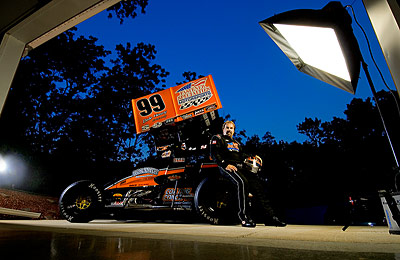 Image #1 The First Set Up … Here is an image of the first lighting set up. Once I have the general set up I try not to make too many adjustments while shooting. Too much running around, moving lights, taking exposure readings, etc. is an easy way to loose your subjects faith in your abilities. This general set up of a single strobe with Soft Box for my main light and a single strobe with reflector for my separation light served as the set up for images 1, 2, 3, 4, and 5. Once this arrangement was in place I could move around, position Frankie and take pictures. We have moved one of the race cars from the garage onto the driveway. The sun has set and so I set my exposure for the twilight sky which would leave my subject in dark silhouette. The use of lighting reveals my subject from the silhouette. The Elinchrom Rangers RX Speed AS is a portable battery power pack and strobe head system that offers 1100 Watt Seconds of power. The “A” Lite Head or sport strobe as I call it has a very fast flash duration of up to 1/5120. I wanted to really blue the twilight sky so I used a cooler WB of 4000K and then added some warmth to my strobes by placing one of Frankie’s orange tinted face shields over the front of each strobe head to counter color the blue WB … (I had forgotten my warming gels but made due with the orange face shields.) Nikon D200, ISO200, 1/250 at f10, Nikon 12-24mm Lens, Zigview Eye Piece, WB 4000K, Power settings for the Rangers: Main Light 5.3 power, Separation Light 5.3 power, Lexar 8G Flash Card. Now we are ready to make pictures ………… Image #1 The First Set Up … Here is an image of the first lighting set up. Once I have the general set up I try not to make too many adjustments while shooting. Too much running around, moving lights, taking exposure readings, etc. is an easy way to loose your subjects faith in your abilities. This general set up of a single strobe with Soft Box for my main light and a single strobe with reflector for my separation light served as the set up for images 1, 2, 3, 4, and 5. Once this arrangement was in place I could move around, position Frankie and take pictures. We have moved one of the race cars from the garage onto the driveway. The sun has set and so I set my exposure for the twilight sky which would leave my subject in dark silhouette. The use of lighting reveals my subject from the silhouette. The Elinchrom Rangers RX Speed AS is a portable battery power pack and strobe head system that offers 1100 Watt Seconds of power. The “A” Lite Head or sport strobe as I call it has a very fast flash duration of up to 1/5120. I wanted to really blue the twilight sky so I used a cooler WB of 4000K and then added some warmth to my strobes by placing one of Frankie’s orange tinted face shields over the front of each strobe head to counter color the blue WB … (I had forgotten my warming gels but made due with the orange face shields.) Nikon D200, ISO200, 1/250 at f10, Nikon 12-24mm Lens, Zigview Eye Piece, WB 4000K, Power settings for the Rangers: Main Light 5.3 power, Separation Light 5.3 power, Lexar 8G Flash Card. Now we are ready to make pictures …………
|
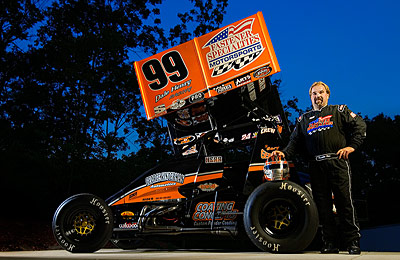 Image #2 Man and Machine … I start simple with a very straight forward image. I placed the camera on the garage floor and used a Zigview (electronic eye piece that attaches to the eye piece of my camera) to see through the view finder and compose the scene. The low angle creates the bigger than life aspect of the subject and is often used with sports and athletes. The deep blue sky helps give depth to the image. Nikon D200, ISO200, 1/250 at f10, Nikon 12-24mm Lens, Zigview, Rangers: Main Light 5.3 power, Separation Light 5.3 power, Lexar 8G Flash Card. Image #2 Man and Machine … I start simple with a very straight forward image. I placed the camera on the garage floor and used a Zigview (electronic eye piece that attaches to the eye piece of my camera) to see through the view finder and compose the scene. The low angle creates the bigger than life aspect of the subject and is often used with sports and athletes. The deep blue sky helps give depth to the image. Nikon D200, ISO200, 1/250 at f10, Nikon 12-24mm Lens, Zigview, Rangers: Main Light 5.3 power, Separation Light 5.3 power, Lexar 8G Flash Card.
|
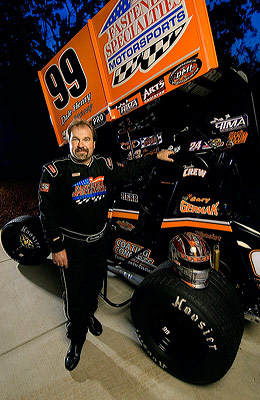 Image #3 Man and Machine 2 … After making some images from a low angle I like to go eye level with my subject. I changed form a horizontal format to a vertical format. All the camera and lighting set up is the same, remember I don’t want to be adjusting lights too often and loose the connection between myself and my subject. I tend to make conversation with my subjects during the shoot. It helps keep them engaged in the portrait process and helps me get to know them. It’s fun to chat. I also like to encourage the subject and let them know they are doing a good job and that the pictures are looking great. I will show them images on the LED screen on the camera quite often. Same camera, lens and lighting settings as the previous images. Image #3 Man and Machine 2 … After making some images from a low angle I like to go eye level with my subject. I changed form a horizontal format to a vertical format. All the camera and lighting set up is the same, remember I don’t want to be adjusting lights too often and loose the connection between myself and my subject. I tend to make conversation with my subjects during the shoot. It helps keep them engaged in the portrait process and helps me get to know them. It’s fun to chat. I also like to encourage the subject and let them know they are doing a good job and that the pictures are looking great. I will show them images on the LED screen on the camera quite often. Same camera, lens and lighting settings as the previous images. |
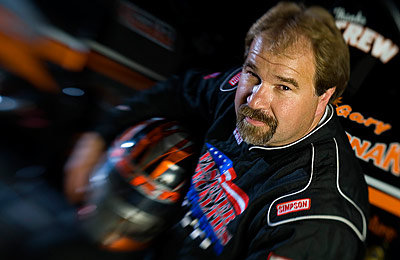 Image #4 Frankie Herr the Legend … From eye level I then changed the perspective again and positioned myself slightly above Frankie and took a few pictures with a Nikon 12-24mm Lens. Then I changed lenses and used a Lensbabie to focus in on Frankie’s left eye and let the “tilt shift look” produced by the Lensbabie to do it’s thing. I like this image. With the Lensbabie mounted to the Nikon D200 the exposed image changed and the test image looked 2 stops over. The Lensbabie has no aperture setting ring and so I made 3 test shots and powered down a little at a time until I had I reduced the power of the Rangers to about 3.0 power. I took a shot and took a look at the LED screen each time until the exposure looked correct. I also noticed that there was a definite color shift with the Lensbabie and made the necessary WB correction during the test shots. Nikon D200, ISO200, 1/250 at No Aperture, Lensbabie with f4 ring, WB 3000K, Rangers: Main Light 3.0 power, Separation Light 3.0 power, Lexar 8G Flash Card. Image #4 Frankie Herr the Legend … From eye level I then changed the perspective again and positioned myself slightly above Frankie and took a few pictures with a Nikon 12-24mm Lens. Then I changed lenses and used a Lensbabie to focus in on Frankie’s left eye and let the “tilt shift look” produced by the Lensbabie to do it’s thing. I like this image. With the Lensbabie mounted to the Nikon D200 the exposed image changed and the test image looked 2 stops over. The Lensbabie has no aperture setting ring and so I made 3 test shots and powered down a little at a time until I had I reduced the power of the Rangers to about 3.0 power. I took a shot and took a look at the LED screen each time until the exposure looked correct. I also noticed that there was a definite color shift with the Lensbabie and made the necessary WB correction during the test shots. Nikon D200, ISO200, 1/250 at No Aperture, Lensbabie with f4 ring, WB 3000K, Rangers: Main Light 3.0 power, Separation Light 3.0 power, Lexar 8G Flash Card. |
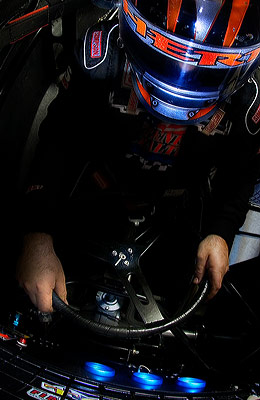 Image #5 Cockpit View … Image #5 Cockpit View … I wanted some pictures of Frankie in the car so I increased the power level of the Rangers up to the original setting of 5.3 power and set my exposure to 1/250 at f5.6 as there was less light inside the car. I also reset the original WB of 4000K. I took 2 or 3 angles of him sitting in the car with his helmet off using a Nikon 17-55mm Lens. Then Bill suggested using the Nikon 10.5mm fisheye. I had Frankie put his helmet on, buckle in and grab the wheel. I stood next to the car, simply pre focused on Frankie, locked the focus and held the camera with the fisheye directly over the cockpit, took a shot and took a look. Way Cool!, as my daughter would say. Nikon D200, ISO200, 1/250 at f5.6, Nikon 10.5mm Fisheye Lens, Rangers: Main Light 5.3 power, Separation Light 5.3 power, Lexar 8G Flash Card. Notice how my separation light that is located off the front of the race car on a small hill has now become my main light source simply because Frankie is looking out the front of the vehicle. I did not move my lights from their original positions as seen in Image #1, but merely made the aperture adjustment for a correct exposure. The original separation light has become my main light and illuminates Frankie’s helmet and face shield while the original main light with the soft box illuminates his hands on the steering wheel, the instrument panel and blue gages.
|
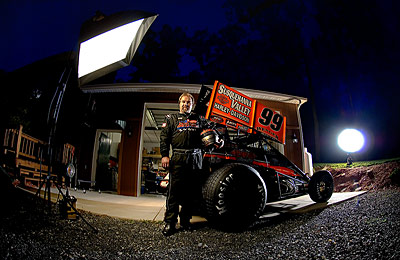 Image #6 2nd Set Up … I felt Frankie deserved a break and I wanted to see a new perspective. This short break of about 5 minutes allowed Bill and I to move the original main light with it’s soft box around to the other side of the car and the separation light around as well. The Rangers are now different distances from our subject than the original set up. Therefore, the power settings will also be different. A test shot reveled that I needed to lower the power setting on the main light power to 3.2 and that I also needed to lower the power of the separation light on the hill to 3.2 power. These settings would expose Frankie to match the garage exposure. ISO250, 1/15 at f2.8, Nikon 10.5mm Fisheye Lens. Rangers: Main Light with Soft Box 3.2 power, Separation Light 3.2 power. Image #6 2nd Set Up … I felt Frankie deserved a break and I wanted to see a new perspective. This short break of about 5 minutes allowed Bill and I to move the original main light with it’s soft box around to the other side of the car and the separation light around as well. The Rangers are now different distances from our subject than the original set up. Therefore, the power settings will also be different. A test shot reveled that I needed to lower the power setting on the main light power to 3.2 and that I also needed to lower the power of the separation light on the hill to 3.2 power. These settings would expose Frankie to match the garage exposure. ISO250, 1/15 at f2.8, Nikon 10.5mm Fisheye Lens. Rangers: Main Light with Soft Box 3.2 power, Separation Light 3.2 power.
|
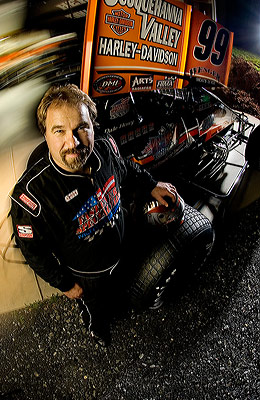 Image #7 Frankie Herr in Motion … I wanted a “racy” look to our final portrait. I took another test shot of the garage with it’s lights on … (ISO200, 1/4 at f4.) This exposure would brighten the illumination of the garage. I also needed to power down the lights to better match the garage exposure, 2.3 power. I explained to Frankie the concept I envisioned, that being having him sharp and the background in a whirl of motion that would suggest the speed of Sprint Car racing. I pre focused my Nikon 10.5mm Fisheye Lens, positioned myself slightly above Frankie and spun the camera clockwise 1/4 turn while taking a picture. The shutter speed of 1/4 and my spin of the camera provided the necessary motion to the background while the flash from the Rangers froze Frankie. I then asked Frankie to rock 10 inches or so towards his left while I took the next picture. This movement gave a slight blur of motion off the right side of his head and shoulder while the spin of the camera whirled the garage background and the flash of course froze Frankie. Again let me say, WAY COOL! Nikon D200, ISO250, 1/4 at f4, Nikon 10.5mm Fisheye Lens, 2 Elinchrom Ranger RX Speed AS battery power packs with Sport Strobe Heads: Main Light with Chimera Super Pro Soft Box 2.3 power and Separation Light with Sport Reflector at 2.3 Power, Pocket Wizard Multi Max Transceivers, Bogen Lightstands, Lexar 8G Flash Card. Image #7 Frankie Herr in Motion … I wanted a “racy” look to our final portrait. I took another test shot of the garage with it’s lights on … (ISO200, 1/4 at f4.) This exposure would brighten the illumination of the garage. I also needed to power down the lights to better match the garage exposure, 2.3 power. I explained to Frankie the concept I envisioned, that being having him sharp and the background in a whirl of motion that would suggest the speed of Sprint Car racing. I pre focused my Nikon 10.5mm Fisheye Lens, positioned myself slightly above Frankie and spun the camera clockwise 1/4 turn while taking a picture. The shutter speed of 1/4 and my spin of the camera provided the necessary motion to the background while the flash from the Rangers froze Frankie. I then asked Frankie to rock 10 inches or so towards his left while I took the next picture. This movement gave a slight blur of motion off the right side of his head and shoulder while the spin of the camera whirled the garage background and the flash of course froze Frankie. Again let me say, WAY COOL! Nikon D200, ISO250, 1/4 at f4, Nikon 10.5mm Fisheye Lens, 2 Elinchrom Ranger RX Speed AS battery power packs with Sport Strobe Heads: Main Light with Chimera Super Pro Soft Box 2.3 power and Separation Light with Sport Reflector at 2.3 Power, Pocket Wizard Multi Max Transceivers, Bogen Lightstands, Lexar 8G Flash Card. |
This was a really fun evening of photography and getting to know Sprint Car driver Frankie Herr. Many thanks to Frankie for being willing and patient with the portrait process. The night before race day is loaded with last minute things to do and I appreciate Frankie opening up his schedule to accommodate me. And a huge thanks to Bill Anderson for inviting me out for the weekend of racing. Bill made all the arrangements with Frankie Herr and both speedways. His hospitality and generosity was fantastic. Thank you Bill.
I hope this edition of Workshop at the Ranch helps spark a few ideas and lighting schemes but more importantly emphasizes the idea that a sports photographer should be versatile and capable of taking good portraiture when called to do so. Be prepared to do a good portrait and see what additional opportunities it leads to.
See you next month at Workshop at the Ranch …………………… Adios, Dave
![]() Hi and welcome to this edition of Workshop at the Ranch. The strength of a sports photographer is in their ability to freeze the action and capture an athlete making the key moment during competition. This tends to come easy for those who cover sporting events on a regular basis. But on many occasions the sports photographer is called upon to do an athletes portrait and although it might not be our strongest photographic talent I want to encourage those who call the courts, fields and stadiums of America their office to be ready when the phone rings and you are asked to do a portrait. More often than not making a good solid portrait will lead to bigger assignments inside the organization and team. When a photographer turns down the job of taking a portrait the PR person will go to someone else ………. and usually never return to you. I’ll admit it, portraits are not my strong point but I like to do them and improve each time I go out the door to do one. Practice and be ready to do this basic job of photography.
Hi and welcome to this edition of Workshop at the Ranch. The strength of a sports photographer is in their ability to freeze the action and capture an athlete making the key moment during competition. This tends to come easy for those who cover sporting events on a regular basis. But on many occasions the sports photographer is called upon to do an athletes portrait and although it might not be our strongest photographic talent I want to encourage those who call the courts, fields and stadiums of America their office to be ready when the phone rings and you are asked to do a portrait. More often than not making a good solid portrait will lead to bigger assignments inside the organization and team. When a photographer turns down the job of taking a portrait the PR person will go to someone else ………. and usually never return to you. I’ll admit it, portraits are not my strong point but I like to do them and improve each time I go out the door to do one. Practice and be ready to do this basic job of photography. 








